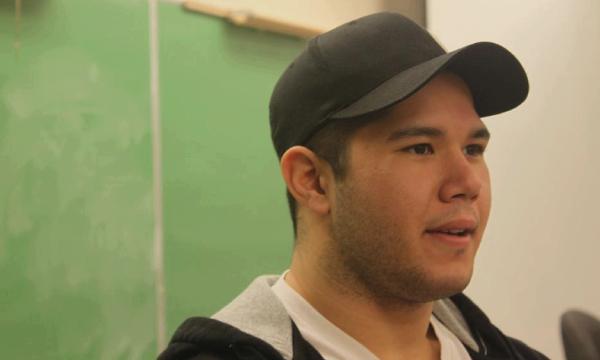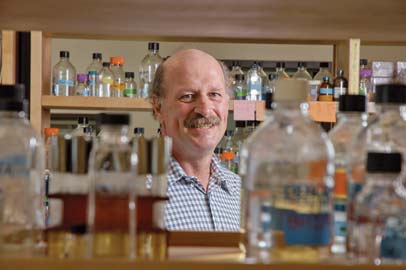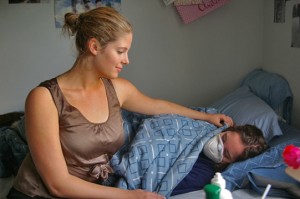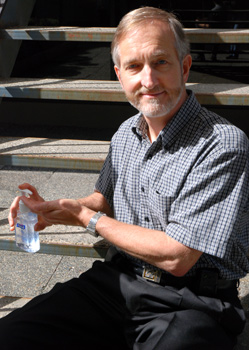Kwantlen, KSA distribute on-campus H1N1 vaccines
January 20, 2010 by Jacob Zinn · Leave a Comment

Brandon Tuason, a history and arts student, thinks it's important for students to get the H1N1 vaccine and keep from spreading the virus through the student population. (Jacob Zinn photo)
In a joint effort, Kwantlen Polytechnic University and the KSA are providing free H1N1 vaccinations this week to students and employees at all four campuses.
Since Tuesday, more than a hundred on-vaccinations have been administered at the Surrey and Richmond campuses.
Lesley England, a registered nurse with ProGroup, said the turnout for vaccinations has been quite good. On Monday, she expected to give 70 vaccinations at the Surrey campus. She gave 88.
By 12:30 p.m. on Tuesday, she’d vaccinated another 45 students on the Richmond campus.
“A lot of people who are getting the H1N1 [vaccine] have never had flu vaccines before,” said England, who is expecting a third wave of the H1N1 influenza virus to arrive in February.
Nurses will visit the Langley campus Thursday and the Cloverdale campus Friday in hopes of immunizing procrastinating students.
When the H1N1 vaccine was being developed last fall, the KSA hoped to include it in the health and dental plan. However, the government purchased enough of the vaccine for all Canadians and offered it for free at clinics.
“It’s readily available now. You can go to your doctor and get the shot,” said Eddie Lee, coordinator of the Student Health Improvement Program.
“However, we know that there are students and employees who probably still won’t go–it’s a lack of convenience for them, so we decided to bring it on campus.”
It’s that inconvenience that has kept Nick Mostar, 22, from finding time for the vaccination.
“I’ve been doing schoolwork and haven’t really had the time to go to a clinic or anything,” said Mostar who is in the engineering program.
Not all students have waited quite as long. Brandon Tuason, 21, got the H1N1 vaccine several months ago. He was at risk of getting the virus because, at birth, he was diagnosed with severe asthma, making him more prone to infection.
“We’re in an environment where everybody’s kinda in close quarters,” said Tuason. “Infections can spread really quickly. I think the school is taking a good initiative in preventing a lot of that by giving the immunization away.”
Anatomy of a virus: A biological breakdown of H1N1
January 13, 2010 by Mitch Thompson · Leave a Comment

File Photo of Dr. Hancock (Courtesy of UBC Media Services)
Strange mutations, odd biological behaviour and the potential to become more deadly have catapulted H1N1, better-known as swine flu, into the scientific limelight.
With the threat of a more deadly version of the virus on the horizon, scientists are trying to understand how this virus came to be, and what it will become.
A team of UBC researchers has made interesting discoveries about H1N1 by studying a different virus: the one that causes avian flu.
The team has been studying how avian flu causes inflammation, and compared it with similar viruses, including H1N1.
“Intrinsically, swine flu doesn’t have the ability to cause inflammation as strong as avian flu,†explained UBC microbiology professor Bob Hancock.
Hancock described H1N1 as “somewhat less harmful and lethal than even the normal seasonal influenzas usually are.â€
However, the British Columbia Centre for Disease Control reports five deaths related to swine flu.
The cause of such deaths could be revealed by research Hancock’s team is doing into systemic inflammation.
“[The viruses] have on them… molecules that are recognized as ‘foreign’ by receptors inside cells, which turns on the inflammatory process,†said Hancock.
This process is a natural defense against these foreign objects, but the trouble comes when flu virus gets into the lungs. The inflammation that occurs can spell disaster if it continues for too long.
“Inflammation in the lungs… causes a lot of fluids to come into the lungs. People literally drown from their own fluids,†said Hancock.
In addition, the virus can worsen secondary infections and cause death, as shown by the 1918 Spanish Flu, which was also a form of H1N1. More than 20 million people died in that outbreak, according to the World Health Organization. Antibiotics had not yet been invented.
Seniors with age-related, health complications are vulnerable to flu-induced complications, but that may not be the case with H1N1.
“Elderly people have seen an H1N1 type virus before. I think the
last outbreak was in the ’70s,†said Hancock. “They tend to have some immunity to this virus…balanc[ing] off the sort of increased susceptibility.â€
A young, healthy person’s lack of existing antibodies may put them at higher risk than someone who was exposed in the past.
However, past exposure and the resulting antibodies don’t necessarily rule out infection, as the swine flu of 1918 and 1970 was not exactly the same as the swine flu of today.
“Flu has the ability to undergo a variety of processes that can change it…so that our body no longer recognizes it,†explained Hancock.
These changes of form are the reason people must be re-immunized every year.
Scientists use the system of H1N1 to categorize various flu strains by the sequence of hemagglutinin (H), the molecule that binds the virus to cells, and neuraminidase (N), the molecule that cuts free freshly made virus cells.
Some strains have similar sequences (swine flu is H1N1, avian flu is H5N1), so they are grouped together although they are biologically different.
The viruses categorized as influenza A, of which swine flu is one, generally have a hard time infecting humans, but H1N1 found a way to adapt itself to allow easy human-tohuman transmission.
“What it looks like is a farm worker managed to acquire two strains of influenza from pigs, and they went through a process known as reassortment,†said Hancock.
The two viruses swapped bits of each other until a new one was eventually created.
The union produced a certain strain that is easily transmitted between human beings.
“It’s really new, and people don’t really have an existing immunity,†he said. “There’s substantial concern that it could mutate in a way that would allow it to become more deadly.â€
Extreme measures to avoid extreme flu
January 13, 2010 by Katie Lawrence · Leave a Comment

In this photo illustration, Milana Jasper (left) and Heather Tijman are demonstrating one method of preventing the spread of the H1N1 virus by wearing a mask when being cared for.
How far would you go to avoid getting the H1N1 virus, more commonly known as swine flu?
Some countries have been taking extreme measures against the virus, but local health authorities say that’s not necessary.
• In April, Egypt ordered the slaughter of the country’s 300,000 pigs, believing it would calm people because pigs are seen as unclean, reported the Sydney Morning Herald.
• The majority of the Japanese public has worn masks since May to avoid the H1N1 virus, thousands of schools were closed and testing centres were flood with people, reported Foreign Policy magazine. Also, Japanese politicians have announced that they will not shake hands with anyone until the H1N1 scare has died down.
• The Big Gig Weekend festival at the Royal Bath and West Showground in Britain has taken out insurance of up to one million pounds for performers Katherine Jenkins, James Morrison, Boyzone and Diversity, in case they come down with the virus, reported the London Telegraph.
• According to l’Agence France-Presse (AFP), when a case of H1N1 was confirmed in a passenger coming from Mexico, Hong Kong quarantined the hotel where the traveller was staying, and tired to track down all the passengers who were on the plane with the man.
• China was prepared to close schools and convert a holiday camp into a quarantine centre when the virus hit the country, reported AFP.
• The Local (Sweden) reported that some Swedish churches have started serving fortified wine at communion, hoping that it will reduce the risk of the spread of H1N1, while others have advised Swedish faithful not to attend communion.
But all the action that needs to be taken is being prepared, said Roland Guasparini, the Chief Medical Officer at the Fraser Health Institute.
“I’ve heard of people avoiding air travel and keeping kids out of their activities, but there’s no need to do anything much more than that,†said Guasparini. “What you need to do is stay healthy, sleep, eat well, get some exercise and keep away from sickies.
“If you do have to look after someone, put a mask on them, so that they’re not coughing all over you, and then wash your hands thoroughly or use an alcohol-based hand sanitizer.â€
Though it’s a bit of an odd idea, Guasparini said that the Japanese politicians may be on to something by not shaking anyone’s hand.
He said that if you shake hands with somone with the virus, and then eat something without washing your hands, you could get the virus. Guasparini thinks that the ru- mour of how H1N1 is contracted – humans getting it from pigs – has been put to rest because of media coverage. He said that it’s actually the other way around: humans give H1N1 to pigs or to other humans.
“[The disease] is passed on per- son-to-person through the eyes, nose and mouth, usually through hand-to-hand contact with objects and then touching your face, where the cells attach to the inside of your nose and/or mouth.â€
Travel costs drop as fear grows
January 12, 2010 by Kirk Darbyshire · Leave a Comment

Amidst H1N1 fears, travelers are still lining up at airports to take advantage of the available travel discounts. (Kirk Darbyshire photo)
Students looking for sun and sand on a budget may be in luck this winter, but they shouldn’t forget to wash their hands.
“Southern destinations are always popular over the holiday season. Even this year, with the H1N1 scare, ticket sales are still very strong,†said Kyko Purvis, a travel agent with Merlin Travel. “It has a lot to do with the great deals available.â€
The Public Health Agency of Canada posted a level one advisory for travel globally because of the H1N1 flu, but has not specifically listed any country as an area of higher risk. The level one advisory is the lowest of three issued by the organization.
As a result of the H1N1 virus outbreak, most airlines, hotels and travel agents have sweetened their deals in an attempt to cash in on the lucrative holiday travel season. Room upgrades, seat upgrades, travel vouchers that cover the cost of your airfare when you book for a week-long stay at a resort, and transfers that will get you from the airport to your hotel for free are all perks being offered for those who are willing to ignore the travel advisories.
“People are weighing the risks to their health against the savings in their pocket-books,†said Purvis, “and booking their tickets, for most, is an easy choice.â€
Dr. Sarah Thrasher, of the Travel Medicine and Vaccination Centre, has seen an increase in people inquiring about the safety of travel to many destinations.
“I’ve been advising people the risk of travelling this year is relatively
no different then that of previous years,†said Thrasher.
Regular hand washing, using hand sanitizers, avoiding people with signs of respiratory illness and being vaccinated – once the vaccine is available to Canadians – are all ways of protecting yourself against H1N1 infection, said Thrasher. Canada has just over 50 million doses of the vaccine on order, and they should be available in early to mid-November. That’s enough for everyone in Canada who wants one to be vaccinated.
“H1N1 causes relatively moderate symptoms in those infected, so people don’t need to feel afraid to travel,†said Thrasher.
Fraser Health predicts and prepares for worst-case flu scenario
January 12, 2010 by Sarah Jackson · Leave a Comment

Dr. Roland Guasparini, chief medical health officer for Fraser Health, models the use of hand sanitizer as protection against H1N1 contraction. (Sarah Jackson photo)
After months of monitoring the southern hemisphere’s H1N1 cases, Fraser Health has determined 40 per cent of the world’s population will catch H1N1 before next April.
The number is twice the yearly 20 per cent seasonal flue infection rate, according to Dr. Roland Guasparini, Fraser Health’s chief medical health officer.
“The vast majority are going to have a mild, self-limiting illness,” Guasparini said. “[But] the flu’s not really mild. You will feel like you get hit with a truck.”
Fraser Health based its estimate on the number of cases that have been reported in the southern hemisphere. As winter and the flu season comes to an end there, the infection rate offers a glimpse into what residents of the northern hemisphere should expect.
Guasparini said Fraser Health has been planning for a severe pandemic for many years, expecting it to surface at any time. The summer arrival of the H1N1 flu suggests that the virus will peak early, over the next eight to 12 weeks, and taper off by December.
The health unit has spent most of its time planning for a worst-case scenario including 200 intensive-care patients, more than Fraser Health facilities can currently house.
To prepare, it has planned alternative treatment sites, purchased additional ventilators and decided how to staff additional health care locations.
“But we’re not going to see that worst-case scenario,” said Guasparini. “We’re expecting, based on the southern hemisphere, that we’ll be able to manage the hospital cases as usual.”
H1N1 is a contagious disease, he explained, so “the attack rate will be the same regardless of the severity of the symptoms.†A mild disease could, however, allow H1N1 to spread more widely than expected if infected people don’t remain home until they recover.
Current concern is for the elderly, children, pregnant women and those with chronic respiratory and cardiac conditions. Those who fall into these categories are at a high risk for severe illness until they receive the H1N1 vaccination, which will not be available until November.
“We’re hoping . . . we just have a seasonal flu year, but the nice thing about all the media attention is that it’s just brought attention to safety conditions,†said Guasparini.
The message about hand-washing, coughing into a shirt sleeve and staying home when sick “has hit home in a big way.â€
He said the media is doing a great job of accurately presenting H1N1 facts. Public-health workers are dealing with the additional strain of responding to patients’ concerns, but the attention devoted to understanding the threats and safety procedures is a new and welcome phenomena.
During previous pandemics, the methods of communication were far more limited.
Guasparini said the international attention and response is a testimony to the system health officials have for monitoring and responding to infectious diseases.
“People are not scared, they just kinda focused their attention.â€
Don MacLachlan, former managing editor at the Province and former director of public relations for Fraser Health, agreed that media has “been doing a very responsible job.â€
MacLachlan said the public perceives H1N1 as a problem, and its status as a pandemic means it is, so the media is rightly informing people about it.
A number of rumours have cropped up since H1N1 first appeared, leaving some people hesitant to trust media coverage. Bulletins have been issued debunking beliefs that H1N1 can be contracted by eating pork, that entire villages in Asia were being wiped out and that the coverage is only hype. But the myths aren’t from the mainstream media, said MacLachlan.
“People aren’t reading or listening to traditional media news. They get news from Facebook, Twitter or MySpace and they treat that as the definitive truth.â€
The media attention has pushed some towards fear or skepticism about the reality of the threat. MacLachlan attributed any “exaggerated state of concern or panic†to individuals who are receiving the media’s messages. He added that “people are hearing and reacting responsibly to responsible messages.â€
H1N1 vaccine might be free for students
January 4, 2010 by Jacob Zinn · Leave a Comment
If H1N1 injections became available to Kwantlen students, they might be covered under the existing student health plan.
The Kwantlen Student Association is looking into the possibility of including H1N1 vaccines in student health benefits. The KSA has contacted Gallivan & Associates, Kwantlen’s health and dental insurance company, and hopes to negotiate the vaccine’s inclusion, should it become widely available.
“We’ve taken steps to make a change to the plan so that that cost would be at least partially or wholly covered by the KSA,†said KSA general manager Desmond Rodenbour.
If the H1N1 vaccine is added to the benefits, Kwantlen will direct students to vaccination clinics for the shot. Rodenbour said he hopes all full-time students on the medical plan would be eligible to receive the immunization.
Currently, the vaccine is still being developed and the KSA doesn’t have a projected cost
for the shot, but it’s expected to be generally available later in the fall. The Public Health Agency of Canada reports that the government intends to purchase 50.4 million doses of the vaccine, enough to cover the population of Canada.
Linda McCannell, a program leader in communicable disease for the Richmond Health Department, said she doesn’t think people in good health should be as concerned about getting infected as those who are illness-prone.
“From what I’ve seen, the severity [of H1N1] tends to be very similar to regular flu,†she said. “It’s pregnant women, it’s children two years of age, it’s people with chronic health problems and those are who we normally immunize for flu [who might have a more severe reaction].â€
Janine Hadfield, a coordinator of the Kwantlen Wellness Centre, said the regular seasonal flu shots will be given on campus near the end of October or early November.
Last year, about 180 staff and students got flu shots on-campus, according to Eddie Lee of the Student Health Improvement Program.
Lee said the number of people getting the shot might increase because of the awareness of the flu virus.
Lee estimated the flu shot will cost $15 to $20, adding that the KSA will subsidize some of the cost for students on the health plan.
Kwantlen is promoting good hygiene, such as washing your hands and covering your mouth when you cough, as defences against the flu in general and H1N1 in particular. Automated hand-sanitizer stations have been installed at main entrances and updates about influenza are available on the Kwantlen website (www. kwantlen.ca/hr/ohs/h1n1.html).
“The primary thing is education,†said Peter Chevrier, Kwantlen’s director of marketing and communications. “If we educate everybody on some of the really fundamental, basic processes, you start to cut down on the likelihood of infection.â€
According to Kwantlen’s Influenza Exposure Control Plan, the Emergency Management Committee would issue a health notice in the event of a major flu epidemic.
Students should be concerned if they have a fever above 38 C and any other H1N1 symptom such as cough or shortness of breath. Suspected and confirmed cases should be reported immediately to Healthlink BC at 8-1-1 and the manager of Kwantlen’s Occupational Health & Safety Office at (604) 599-2924.
Much of the Influenza Exposure Control Plan is about precautions to stop the spread before it starts.
Local and regional health authorities would decide if school closures are needed. Kwantlen, however, is not restricted from implementing its own preventive measures, said Chevrier.
“We have a lot of freedom to do what we feel is the best in order to provide a level of commitment to the health and safety of our students,†he said.
He added that the janitorial crews have been trained for more thorough and frequent decontamination, such as sanitizing doorknobs and handrails.
The Public Health Agency of Canada has reported five cases of H1N1 in B.C. There are no reports of H1N1 affecting anyone at Kwantlen.
KSA may not need H1N1 vaccine in student health plan
November 1, 2009 by Jacob Zinn · Leave a Comment
The Kwantlen Student Association likely won’t have to cover the cost of the H1N1 vaccine for students under its health and dental plan.
The student association originally wanted to include the vaccine in the health plan and subsidize some or all of the cost, but the federal, provincial and territorial governments might pay for vaccinations for students.
“At this stage, it looks like they may be offered for free by the province,†said Desmond Rodenbour, general manger of the KSA. “However, if there is a charge, we’re going to make sure they’re covered under the health and dental plan.â€
The Public Health Agency of Canada has said the federal government will cover 60 per cent of the cost, leaving provincial and territorial governments to cover the difference if they choose.
Although the university provides seasonal flu shots, they will not have H1N1 vaccines on campus, according to Janine Hadfield of the Kwantlen Wellness Centre.
“It’s going to be totally regulated by Public Health,†said Hadfield. “The roll-out starts with [people with] chronic illness and pregnant women, then it goes to young under six and further down the road it’s for the everyday person.â€
Hadfield noted that health regions in the Lower Mainland may distribute the vaccine differently.
Currently, the vaccine is only available to specific groups, such as pregnant women and adults under 65 with chronic illnesses.
Vancouver Coastal Health and Fraser Health is planning to make the H1N1 shot available to everyone in mid-November.


